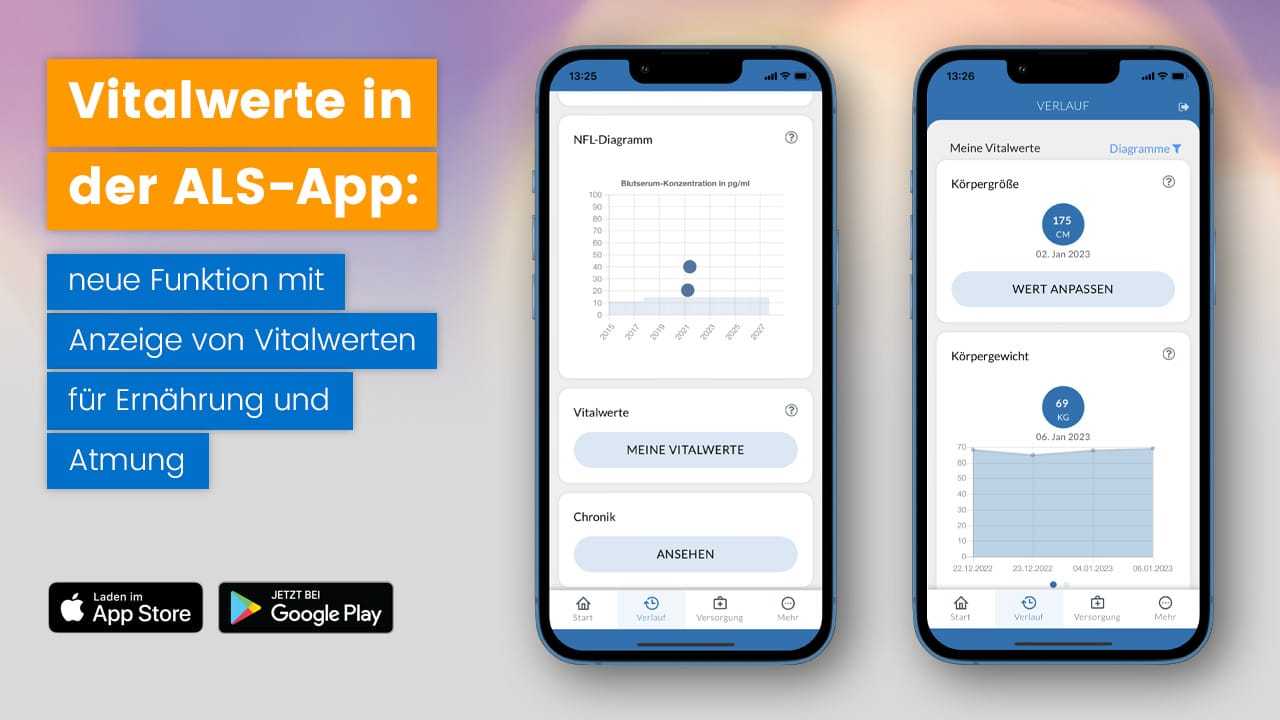we have added the display of vital signs for nutrition and respiration as a new feature in the ALS app. The current version of the ALS app (version 4.0.8) is available for download free of charge from the Apple App Store and Google Play. We would like to briefly introduce the new display of vital signs.
My vital signsVital signs are measurements that record important bodily functions. The most important vital signs in ALS are respiration and nutrition – measured by the Body mass index, the Vital capacity of the lungs and the Cough Tip Push. These vital signs provide important information for nutrition and ventilation therapy in ALS. In the ALS app, the values are displayed over time as a diagram and table in the „My vital signs“ area. The values can be entered via your ALS app or your patient account in the outpatient care portal. The values are entered by yourself, by the treatment team in your ALS outpatient clinic or via our data management.
Body sizeThe body size is needed for the determination of the body mass index (BMI). With the help of the BMI, an assessment of the nutritional requirements and the provision of suitable nutritional products can be made.
_Figure on the left: My vital signs
On the History page you will find the ‚My vital signs‘ section.
Figure middle: Body size
The current body height is displayed in the vital signs.
Figure on the right: Entering the body size
Via ‚Adjust value‘ the input mask for the current body height opens.
_
Unwanted weight loss affects more than 50% of all people with ALS. The weight loss can have various causes. A dysphagia with reduced food intake, increased energy demand due to respiratory dysfunction or an ALS-associated metabolic disorder can cause unwanted weight loss.
Weight loss is significant to disease progression, as malnutrition and undernutrition can be associated with reduced quality of life as well as shortened lifespan. In the ALS app, body weight is displayed as a vital sign over time.
Figure on the left: Course of the body weight
Page ‚My vital signs‘ with development of body weight as a progress chart.
Figure center: Body weight in tabular form
A drop-down menu in the upper right corner allows the display of the body weight over time.
Figure on the right: Entering the body weight
The ‚Add value‘ button opens the input mask for the current body weight
Weight loss has prognostic significance in ALS and should be prevented or effectively treated by optimal nutritional care. Body weight and height are important in the calculation of energy requirements. The relationship between body weight and height is determined in the so-called body mass index (BMI). BMI is calculated as body weight in kg/(height in meters)². For a person with a height of 1.7 m and a weight of 80 kg, the BMI is calculated as follows: 80 kg /(1.7 m)2 =27.7 kg/m2. A BMI below 18.5 kg/m2 is considered underweight and in need of treatment. In the ALS app, the BMI is calculated and the development over time is displayed in the vital signs.
Figure on the left: Course of the BMI
On the page ‚My vital signs‘ you will find the development of the BMI over time in the form of a progress chart.
Figure right: BMI in a table
A selection menu in the upper right corner enables the display of the time course of the BMI as a diagram or table.
Vital capacity (VC) is a parameter of pulmonary function diagnostics. A reduced respiratory capacity can be determined by the respiratory test of the VC. The VC measurement is a central value that is regularly determined in ALS outpatient clinics and used as a basis for decision-making for possible treatment measures. The measurement of VC can be performed in different ways: by fast inhalation and exhalation (FVC, forced vital capacity) or by slow inhalation and exhalation (SVC, slow vital capacity). The SVC value is displayed in the ALS app.
Figure on the left: Course of vital capacity
Development over time of the vital capacity of the lungs in the form of a progress chart on the page ‚My vital values‘.
Figure center: History in tabular form
A selection menu enables the display of the time course of the vital capacity of the lungs as a table.
Figure on the right: Entering the vital capacity
The button ‚Add value‘ opens the input mask for the current value of the vital capacity.
Die ALS kann zu einer Beeinträchtigung der Atemmuskulatur führen. Damit kann auch eine Schwäche des Hustens verbunden sein. Die Hustenschwäche zeigt sich in einer Verminderung des »Hustenstoßes«. Die Stärke des Hustens lässt sich durch die Messung des Hustenspitzenstoßes (Peak Cough Flow, PCF) ermitteln. Der Hustenspitzenstoß gibt die maximale Ausatmungsgeschwindigkeit während eines Hustenstoßes. Er liegt bei Erwachsenen normalerweise oberhalb von 270 l/min.
Figure on the left: Course of the cough peak impact
Page`My vital signs‘ with time course of the values of the cough peak shock.
Figure center: Tabular progression of the cough peak impact.
A drop-down menu allows the progress of the cough peak impact to be displayed in tabular form.
Figure on the right: Entering the current value of the cough peak impact.
The ‚Add value‘ button opens the input mask for the current value of the cough peak impact.
We appreciate your interest in the ALS app. If you have any questions or would like support in using the new ‚My Vital Signs‘ function, please do not hesitate to contact us:
Felix Kolzarek
support@ambulanzpartner.de
Tel. 030-81031410
Ihr APST-Team
